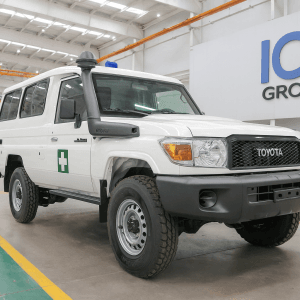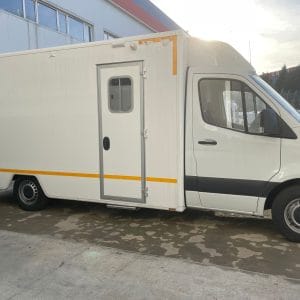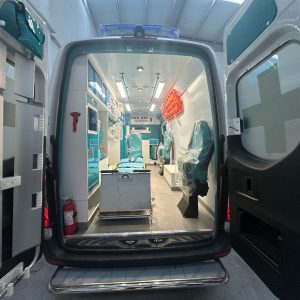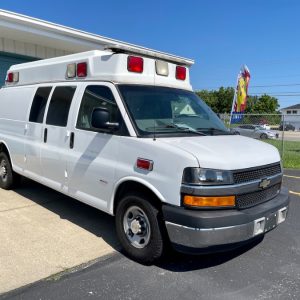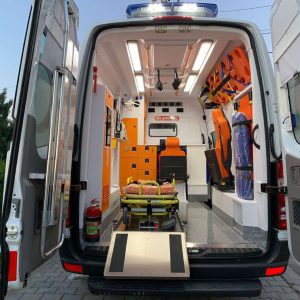Introduction
Hyundai H1 Ambulance ; The Hyundai H-1 is a multipurpose vehicle that has been manufactured by Hyundai since 1997. It is sold under various nameplates around the world, including the Hyundai Starex, Hyundai Satellite, and Hyundai Libero.
One of the most popular variants of the H-1 is the ambulance model. The H-1 ambulance combines the versatility and spaciousness of a commercial van with specialized medical equipment and features tailored for emergency medical services.
There are several reasons why the Hyundai H-1 makes for an excellent ambulance:
- Spacious interior: With multiple seat configurations available, there is ample room in the back to transport patients on stretchers and accommodate medical equipment and EMTs. The high roof provides easy standing room and access.
- Powerful performance: The H-1 ambulance is equipped with diesel engines that provide sufficient power to transport patients quickly and safely. Models with automatic transmission improve driveability.
- Reliable and durable: Built on a rugged commercial van platform, the H-1 ambulance is designed for heavy-duty use and challenging road conditions. The unibody construction and rear-wheel-drive provide stability and control.
- Customizable options: Hyundai offers many ambulance-specific options and conversions, including emergency lighting, sirens, climate control, and different layouts to meet unique needs.
- Cost-effective: Compared to other ambulance options, the Hyundai H-1 provides great value by delivering capable emergency performance at a relatively affordable price point.
With its balance of space, power, durability, and flexibility, the Hyundai H-1 has become a popular choice for ambulance fleets and emergency medical services around the world.
Hyundai H1 Ambulance Exterior Design
The Hyundai H1 ambulance has a distinctive boxy exterior design that maximizes interior space while still remaining maneuverable. It is based on the Hyundai H1 panel van, but with modifications to accommodate medical equipment and emergency response capabilities.
Some key exterior features include:
- Streamlined front grille and bumper providing good approach angle for navigating rough terrain or crowded city streets. Includes integrated lights and sirens.
- Sliding side door provides easy access for loading patients on a stretcher. Wide opening and low step-in height.
- Rear liftgate doors open 270 degrees allowing unobstructed access to the patient cabin from the back.
- Large windows all around provide good visibility for the driver and allow natural light into the patient cabin.
- Roof-mounted emergency lights are aerodynamic and do not create a lot of wind noise.
- Durable and dent-resistant body panels that can withstand the rigors of emergency response driving.
- Available in rear-wheel-drive and all-wheel-drive configurations. Higher ground clearance for AWD models.
- Comes in a range of solid colors as well as emergency vehicle color schemes with high visibility reflective striping.
The Hyundai H1 ambulance has an optimized exterior design making it functional and practical while still maintaining a professional emergency response aesthetic. The boxy shape provides ample interior space while the smooth styling enhances drivability.
Interior and Cargo Space
The Hyundai H1 Ambulance has a spacious interior layout designed for transporting patients comfortably and safely. It has seating for the driver plus up to 10 passengers.
The ambulance has an open cargo area in the rear with generous dimensions. The length of the cargo area is approximately 1.8 meters. The width between the wheel arches is 1.3 meters. The height from floor to ceiling is 1.3 meters. This provides ample space for a stretcher, medical equipment, and medical personnel attending to the patient.
There are grab handles on the ceiling and sides of the cargo area for safely securing the stretcher during transport. The floor is flat and easy to clean. There are also storage compartments along the side walls for extra equipment. Overall, the cargo space is thoughtfully laid out and provides an efficient workspace for EMTs to administer care.
Up front, the driver and passenger seats are comfortable and adjustable. The dash features clear gauges and controls within easy reach. There are cupholders, storage bins, USB charging ports, and a rearview camera display for convenience. The cabin layout focuses on ergonomics and functionality for the driver.
Engine and Transmission
The Hyundai H1 Ambulance comes equipped with a 2.5L CRDi diesel engine that produces 130 hp and 255 Nm of torque. This 4-cylinder engine provides decent power while optimizing fuel efficiency.
For the transmission, Hyundai offers a choice between a 5-speed manual gearbox or a 4-speed automatic transmission. The manual transmission allows for greater driver control and responsiveness. Meanwhile, the automatic gearbox offers smooth, convenient shifting.
Some key engine specs include:
- Displacement: 2,497 cc
- Maximum power: 130 hp @ 3,800 rpm
- Maximum torque: 255 Nm @ 1,900 – 2,750 rpm
- Fuel system: Common rail direct injection
- Emission standard: Euro 4
The manual transmission is a 5-speed unit, while the automatic is a 4-speed gearbox. The auto transmission features a lock-up torque converter to improve fuel efficiency at highway speeds.
Overall, the H1 Ambulance’s powertrain provides a good blend of power and efficiency to transport patients smoothly and comfortably. The engine produces adequate torque low in the rev range, enabling easy drivability especially in urban conditions.
Safety Features
The Hyundai H1 ambulance is designed with safety in mind for both patients and medical personnel. It has a range of active and passive safety features:
Active Safety Features
- Anti-lock Braking System (ABS) – Prevents the wheels from locking up and skidding during emergency braking situations. This allows the driver to maintain steering control.
- Electronic Brakeforce Distribution (EBD) – Balances braking force between front and rear wheels for improved braking performance. Helps prevent rear-wheel lockup.
- Electronic Stability Control (ESC) – Detects loss of traction when cornering and automatically applies brakes to individual wheels to stabilize the vehicle.
Passive Safety Features
- Airbags – Driver and passenger front airbags are standard. Side curtain airbags provide head protection in side impacts.
- Seatbelts – 3-point seatbelts are equipped for all seating positions. The driver’s seatbelt has a pretensioner and load limiter.
- Body Construction – Reinforced body structure and crumple zones absorb impact forces and direct them away from occupants.
- Child Seat Anchors – LATCH anchors allow secure installation of child seats.
The Hyundai H1 ambulance provides crucial active safety technologies like ABS and ESC to help avoid accidents. It also has robust passive safety features to minimize injury in a crash. This combination gives medical personnel and patients confidence during emergency response driving situations.
Medical Equipment
The Hyundai H1 ambulance comes equipped with top-quality medical equipment to provide emergency medical services. The ambulance conversion is done by certified specialists to ensure the vehicle meets industry standards.
The ambulance has an integrated stretcher system with a powered lift to easily load patients into the back. The stretcher locks in place for safe transport. There are also seating positions and safety harnesses for medical attendants to monitor the patient enroute.
Oxygen cylinders, suction units, defibrillators, and other critical medical equipment can be installed and properly secured. Cabinets, drawers, and compartments allow equipment to be organized for quick access. An IV pole, glove dispenser, and sharps container are standard features.
There is ample room in the back for a movable doctor’s seat, biohazard trash can, and other necessary medical supplies. The interior walls and floors are easy to clean and disinfect.
The ambulance also has an integrated LED warning lightbar and siren system for responding to emergencies. Additional scene lights, backup alarms, and side flashing lights can be added.
Overall, Hyundai H1 ambulances provide customizable medical equipment installations to meet the needs of emergency medical teams. The spacious interior and layout allow for efficient medical care on the go.
Comfort and Convenience
The Hyundai H1 ambulance is designed with comfort and convenience in mind for both patients and medical professionals. Some standout features include:
- Spacious interior with ample headroom and legroom in both the passenger and cargo areas. The high roofline allows patients and paramedics to move about with ease.
- Reclining stretcher with adjustable positions for patient comfort. The stretcher can also swivel for ease of entry and exit.
- Medical equipment like IV poles, oxygen tanks, and monitoring devices are ergonomically placed and easy to access.
- Generous storage for medical supplies and personal items. Cabinets, compartments, and hooks keep everything organized.
- Tinted privacy glass and curtains allow patients privacy while being transported.
- Easy to clean surfaces, materials, and minimal crevices help maintain sanitary conditions.
- Automatic climate control system keeps interior at comfortable temperatures for all occupants. Separate A/C vents for patient area.
- Radio, USB ports and 12V sockets allow for music, device charging and entertainment during transit.
- Hyundai’s advanced Blue Link telematics system provides useful information and connectivity for drivers through a central touchscreen interface.
The Hyundai H1 ambulance balances purpose-built medical accommodations with car-like comforts and conveniences for a smooth and pleasant transport experience. The spacious, well-equipped cabin tends to both patient and paramedic needs.
Driving Dynamics
The Hyundai H1 ambulance is designed to provide a smooth and stable ride, which is essential for transporting patients comfortably. The suspension is tuned to absorb bumps and undulations in the road while maintaining composed handling.
Despite its large size, the H1 feels relatively nimble thanks to its car-like unibody construction and precise steering. The turning radius is respectable for a vehicle of this size, making it maneuverable in tight city streets. Power comes from a 2.5L diesel engine mated to a 5-speed manual or 4-speed automatic transmission. There is sufficient power on tap to motivate the H1 ambulance even when fully loaded.
Ride quality is a key priority for an ambulance, as patients should not be subjected to a harsh and jarring experience over uneven roads. The H1’s long wheelbase and suspension tuning help to isolate occupants from bumps and vibrations. Noise insulation also keeps the cabin quiet, allowing for restful transport.
As an ambulance, the H1 needs to be capable of traversing all kinds of roads from highways to rutted rural paths. Its high ground clearance and four-wheel drive capability equip it for off-road use when required. Overall, the H1 ambulance balances composed on-road manners with off-road readiness.
Fuel Efficiency
The Hyundai H1 ambulance offers respectable fuel economy for a vehicle of its size and purpose. It is powered by a 2.5L turbocharged diesel engine mated to a 6-speed automatic transmission. This powertrain combination allows the H1 ambulance to achieve fuel consumption figures of 8.7L/100km on the combined cycle. In city driving, fuel economy is rated at 10.5L/100km and 6.8L/100km on the highway.
With its 75L fuel tank, the H1 ambulance can travel approximately 860km between fill ups when driven conservatively. This gives it sufficient range to operate throughout a full shift without needing to refuel. Even under demanding conditions with the engine working hard, real world fuel economy should remain in the 10-12L/100km range. Overall, the H1 ambulance balances hauling capacity and performance with respectable fuel efficiency for an emergency response vehicle.
Pricing
The Hyundai H1 Ambulance starts at around $50,000 for the base model. However, pricing can vary significantly depending on the level of medical equipment and customization. Some key factors that affect the price include:
- Engine and transmission: The H1 Ambulance comes standard with a 2.5L diesel engine and 5-speed manual transmission. Upgrading to a more powerful engine or automatic transmission adds $2,000 – $5,000 to the price.
- Medical equipment: Basic models include a stretcher, basic life support equipment, and oxygen. Additional options like a defibrillator, suction unit, cardiac monitor or other advanced life support gear can add $5,000 – $15,000.
- Interior customization: Custom cabinetry, storage, lighting, and electrical upgrades for medical devices can add a few thousand dollars.
- Exterior modifications: Graphics, emergency lights, sirens, and other exterior add-ons cost extra.
- Warranty and maintenance: Extended warranty and maintenance plans are available to cover the specialized ambulance components. This typically costs a few thousand dollars.
In general, a moderately equipped H1 Ambulance with some medical devices and customization will cost around $65,000 – $75,000. Fully loaded intensive care capable models can run $90,000 – $100,000 or more. Government and other fleet buyers may get discounts when purchasing multiple units. For private ambulance operators, the Hyundai H1 represents an affordable mid-range option compared to more expensive Sprinter, Transit, or Type II models. Careful selection of options allows buyers to equip the H1 Ambulance for their specific needs and budget.




